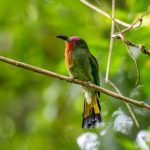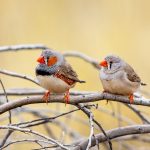The lives of birders are meted out in ticks and dips, and for every epic tale of the mega discovered and added to one of many lists, there are even more fascinating stories told of the birds that got away. We birders don’t always like to ruminate on missed birds, for some of us the wounds are worn too close to the surface. But I happen to think that those stories are better than the ones with happy endings. Not only do they stop to remind us that this birding thing is tough and the birds don’t always cooperate as well as we want them too, but they are truly equal opportunity failures. Every birder, from old hand to rank amateur has stories like this. We can all empathize with birds we don’t get far more than birds we get. Or maybe these are the things I tell myself when i realize I have way way way more than my share of birds that got away.
And this one, friends, may be the biggest one yet.
By a combination of fortunate travels and a handful of nice vagrancies, I have found myself with a life list that contains all the regularly occurring hummingbirds in the ABA Area (not including Green Violetear and Plain-capped Starthroat and whatnot) save one. The tiny desert spitfire known as Costa’s Hummingbird. I needed it. Needed it in that way that only the unrepentant lister can really need a bird. You all know, even if you deny it. And while I was in Arizona, touring the Huachucas with Swarovski (along with 10KB notables Mike Bergin and Birdchick Sharon Stiteler among others), I had in the back of my mind that I might be able to pick up that last hummingbird. And I wanted the complete set.
Now, I knew it was a longshot. For starters, Costa’s is a desert species and we were primarily up in the mountains. And second, August is not the best time of year to find them, as they spill into Arizona during the winter months. But there had been a few hanging around some of the hummingbird hotspots in the region, and it wasn’t out of the realm of possibility for us to come across one.
Plus, we had an ace in the hole in a way. Joining us for the day was Sheri Williamson, who literally wrote the book on hummingbirds in North America. Sitting around and watching the feeders with her is sort of akin to having a catch with Stan Musial. So if there was anyone in the world who would be able to pick a Costa’s Hummingbird out of thin air and set it down in front of me, that person was with us. I had to like my odds.
The Costa’s that had been visiting the feeders at the Beatty’s Guest Ranch was a no-show. Instead I was forced to wade through torrents of Broad-billed, Blue-throated, Rufous, Magnificent, Anna’s, Broad-winged, and Black-chinned Hummingbirds. A tough slog, but rest assured I was up for it.
Having censused the hummers at Beatty’s, we headed to Ash Canyon B&B. Target birds for this portion of the trip included Lucifer Hummingbird and Plain-capped Starthroat. I’ll spare you the nitty-gritties but we picked up the first (two of them) and dipped on the second. No matter, Lucifer may have been the target for most, but I’d already seen one years ago. They’re gorgeous, but the capper for me would have been the Costa’s Hummingbird that several of the watchers had assured me was passing through periodically. Other gawked at the magenta-throated dazzler, but I only had eyes and ears for another. The last missing piece.
Sheri had heard it overhead as it passed by, and even Mike managed the briefest of glimpses as it stopped at a feeder before moving on. The hunt was on in earnest. My quarry was near.
And then, a tiny bird paused in the desert mesquite long enough to get glass on it. Things looked right. The darker purplish gorget. The white blaze between throat and cap. I called out, “Costa’s!” Even Sheri Williamson gave her stamp of approval. Congratulations were heard from my assembled companions. Target nailed.

COSTA’s!! Costa’s?
But then the bird turned, and things didn’t look quite right. The tail, for starters, wasn’t long enough. Costa’s has a short tail, no longer than the wings. On this bird, that was enough to dismiss that ID outright. But into what box does it fit?

Tail too long. Gorget too pink. This thing doesn’t add up.
Sheri had the answer. For the past couple years an apparent Costa’s x Lucifer Hummingbird hybrid had been present at Ash Canyon. Our encounter was the first report in 2012 of this particular individual’s return. A cool bird to be sure, but not the one I was looking for.

A female Anna’s Hummingbird channels my rage at this charlatan
So with one possible Costa’s thrown out on a technicality, I redoubled my efforts. It wasn’t long, though, before Sheri picked up another hybrid Costa’s, this time a Costa’s x Black-chinned Hummingbird. This one was not an individual you’d mistake for a pure bird by any means, as it mostly resembled the Black-chinned side of the family in size and structure. But the gorget was purplish all the way up to the chin and flared at the corners just slightly. Another half hummingbird.
At this point I was cursing the promiscuity of this particular species, it having denied me a full-blooded lifer on at least two occasions. but the truth is that either of these hybrids are actually rarer than any real-deal Costa’s would have been at the same place and time. I mean, what are the odds?
Not great, but not bad either. Apparently Costa’s Hummingbirds have been recorded hybridizing with both of these species (and according to Pyle, a handful of others too). In fact, even a cursory google search brought me results on several different incidences on several different bird blogs. So yeah, pretty cool. Even if I couldn’t count either of the halves towards a full lifer.
So I guess I’ll keep looking for Costa’s Hummingbird. That milestone will just have to wait.













According to this logic, which I approve of, most birders in North America will have to delete Iceland Gull from their life lists as the form Kumlien’s, which is pretty much the only one occurring regularly, is now mostly thought of as a hybrid between “pure” glaucoides and Thayer’s.
Did you see a Kumlien’s?
*Ouch* Bad comment, baaaaad comment! 🙂
You have my deepest sympathies, this must have been truly frustrating. Now, I could tell you one should always dip on one lifers just to have a reason for coming back, but whenever someone tells me this after a terrible dip, all I want is to slap them over the head.
The photo of the Anna’s bombarding the charlatan is great!
I was there 2 weeks ago, and also saw the hybrids. Lucifer and Calliope were lifers. Hope you get your bird!
So…female hummingbirds will mate with any pretty face, they are such hussies!
I was honored to be there for that epic dip. It was a hilarious moment that I’ll never forget.